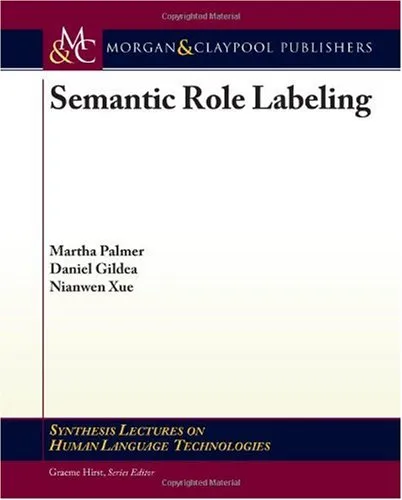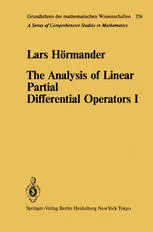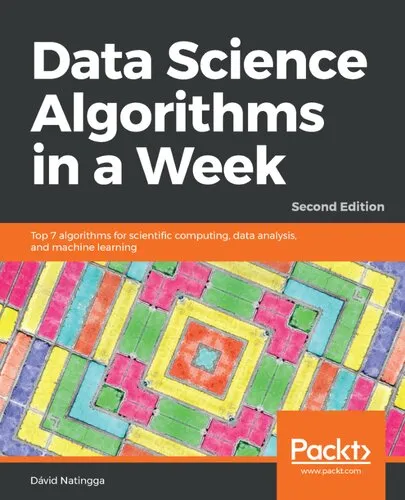Semantic Role Labeling (Synthesis Lectures on Human Language Technologies)
4.5
بر اساس نظر کاربران

شما میتونید سوالاتتون در باره کتاب رو از هوش مصنوعیش بعد از ورود بپرسید
هر دانلود یا پرسش از هوش مصنوعی 2 امتیاز لازم دارد، برای بدست آوردن امتیاز رایگان، به صفحه ی راهنمای امتیازات سر بزنید و یک سری کار ارزشمند انجام بدینکتاب های مرتبط:
معرفی کتاب Semantic Role Labeling
کتاب Semantic Role Labeling یکی از مفصلترین و بنیادیترین منابع موجود در زمینه تحلیل معنایی زبان طبیعی است. این اثر توسط سه نویسنده برجسته، Martha Palmer، Daniel Gildea و Nianwen Xue نوشته شده و به عنوان بخشی از مجموعه Synthesis Lectures on Human Language Technologies منتشر شده است. با تمرکز بر تکنیکها و کاربردهای پیشرفته Semantic Role Labeling (SRL)، این کتاب خوانندگان خود را با دانش عمیقی از این حوزه آشنا میکند.
خلاصهای جامع از کتاب
کتاب Semantic Role Labeling یک نمای جامع و دقیق از تمامی جنبههای SRL، یکی از ابزارهای کلیدی در تحلیل معناشناختی زبان طبیعی، ارائه میدهد. SRL فرآیندی است که در آن، برای عبارات زبانی نقشهای معنایی مشخصی تعریف میشود. این روش به ما کمک میکند تا بفهمیم اجزای مختلف یک جمله چه وظیفهای در انتقال معنا دارند، مثلاً چه کسی فعل را انجام داده، چه چیزی از فعل تأثیر میگیرد و کجا یا کی آن رخداد به وقوع پیوسته است.
در این کتاب، نویسندگان تاریخچه شکلگیری و تکامل SRL را بررسی میکنند، ابزارها و تکنیکهای متنوع آن را تحلیل میکنند و نمونههای متنوعی از کاربرد این روش در حوزههای عملی همچون ترجمه ماشینی، پاسخ به پرسشها و استخراج اطلاعات را به نمایش میگذارند. یکی از ویژگیهای برجسته این کتاب این است که به توازن دقیق میان مباحث تئوری و عملی توجه دارد و از این طریق هم برای پژوهشگران و هم برای مهندسان نرمافزار مفید است.
نکات کلیدی کتاب
- تعریف دقیق و عمیق از مفهوم Semantic Role Labeling و اهمیت آن در تحلیل زبانی.
- بررسی الگوریتمهای پایهای و پیشرفته برای انجام SRL.
- آشنایی با چارچوبهای Annotated Corpora و نقش آنها در پیشرفت پژوهشهای SRL.
- معرفی ابزارهایی چون PropBank و FrameNet به عنوان منابع کلیدی در SRL.
- مطالعه موردی از کاربردهای عملی SRL در زمینههای متنوع مانند پردازش گفتار و تحلیل احساسات.
نقلقولهای معروف از کتاب
"Semantic Role Labeling serves as the backbone of semantic understanding in natural language processing."
"By identifying who did what to whom, when, where, and why, we get closer to unlocking the full potential of meaning embedded in text."
چرا این کتاب اهمیت دارد؟
در دهه گذشته، پیشرفتهای چشمگیر در زمینه یادگیری ماشین و هوش مصنوعی امکان تحلیل زبان طبیعی را به میزان قابلتوجهی بهبود دادهاند. در این میان، فیلد SRL نقش بسیار حیاتیای در درک بهتر زبان و معنای آن ایفا میکند. کتاب Semantic Role Labeling به عنوان یک منبع پیشرو، به خوانندگان کمک میکند تا به شکلی دقیق با تکنیکها و کاربردهای این حوزه آشنا شوند.
این اثر نه تنها برای پژوهشگران و دانشجویان دانشگاهی که در حوزه پردازش زبان طبیعی فعالیت میکنند مناسب است، بلکه برای مهندسین نرمافزار و متخصصان هوش مصنوعی که به دنبال پیادهسازی تکنیکهای معنایی در پروژههای خود هستند، اطلاعات ارزشمندی ارائه میدهد. با وجود مثالهای کاربردی فراوان و توضیحات جامع، این کتاب ابزاری ضروری برای هر کسی است که در این حوزه به دنبال دانش عمیقتر است.
Introduction to "Semantic Role Labeling"
"Semantic Role Labeling (Synthesis Lectures on Human Language Technologies)" is an authoritative and comprehensive book written by Martha Palmer, Daniel Gildea, and Nianwen Xue, three renowned experts in the field of computational linguistics. This book serves as an essential guide to the technique of Semantic Role Labeling (SRL), a vital component of natural language understanding and one of the key pillars of modern artificial intelligence applications in language technology.
Semantic Role Labeling focuses on determining the relationships between a sentence’s predicate and its arguments, enabling systems to comprehend "who did what to whom, when, where, and how." It sits at the intersection of syntactic analysis and semantic interpretation, transforming raw text data into structured, actionable meaning representations. Whether you're a beginner in the field or a seasoned researcher, this book gives you the foundations and insights to grasp the theory, practice, and applications of SRL in a hands-on and accessible manner.
Detailed Summary of the Book
The book is divided into several thoughtfully designed chapters, each addressing a key aspect of Semantic Role Labeling. It begins with a historical overview of SRL, tracing its roots back to computational linguistics and the role of case grammar in defining semantic roles such as agents, patients, and instruments. The authors provide a thorough exploration into the linguistic theories underpinning SRL, including the works of Fillmore and the FrameNet project.
Moving beyond theory, the book transitions into practical methodologies for training and testing semantic role labeling systems. It delves deeply into both supervised and unsupervised machine learning techniques, highlighting the challenges of feature engineering, sparsity in labeled data, and the role of linguistic resources such as PropBank and VerbNet. The authors also discuss the impact of neural networks on SRL performance, examining how embeddings, attention mechanisms, and recent transformer-based architectures like BERT have revolutionized the field.
Lastly, the book explores real-world applications of SRL in fields like information extraction, machine translation, question answering, and summarization. By the end of the book, readers will not only have a clear understanding of how SRL works but also how it fits within the broader context of AI and its contributions to advancing natural language processing research.
Key Takeaways
- Learn the fundamental concepts and theories behind Semantic Role Labeling and its importance in natural language processing.
- Master the practical steps for building SRL systems, including detailed discussions on linguistic annotation frameworks like PropBank and FrameNet.
- Understand the evolution of SRL techniques, from symbolic rule-based methods to modern deep learning approaches.
- Explore cutting-edge trends in SRL research, including transformer-based models and multilingual extensions.
- Gain insights into real-world applications of SRL and how it enables machines to understand language meaning at a deeper level.
Famous Quotes from the Book
"Semantic Role Labeling is not just about labeling roles; it’s about enabling machines to understand the actions, participants, and contexts embedded in human language."
"The road from syntax to semantics is arduous, but SRL serves as the bridge that brings machines closer to understanding the nuances of human communication."
"As we continue to teach machines the essence of meaning, Semantic Role Labeling remains a cornerstone of the quest for natural language understanding."
Why This Book Matters
In the rapidly evolving domain of artificial intelligence, understanding language meaning is central to building smarter and more intuitive systems. "Semantic Role Labeling" is an indispensable resource for both academics and practitioners who aim to develop natural language processing systems that go beyond surface-level analysis. This book not only provides the tools and techniques to build effective SRL systems but also establishes a firm grounding in the history and philosophy of semantics in computational linguistics.
With the increasing demand for sophisticated AI applications like intelligent personal assistants, sentiment analysis, legal document analysis, and automated content summarization, Semantic Role Labeling plays a foundational role in bridging the gap between sentence syntax and its semantic interpretation. By empowering readers with a deep understanding of this critical area, the authors contribute significantly to advancing the reach and capabilities of computational linguistic technologies. Whether you aim to pursue cutting-edge research or develop next-generation AI applications, this book will undoubtedly become a key reference in your library.
دانلود رایگان مستقیم
شما میتونید سوالاتتون در باره کتاب رو از هوش مصنوعیش بعد از ورود بپرسید
دسترسی به کتابها از طریق پلتفرمهای قانونی و کتابخانههای عمومی نه تنها از حقوق نویسندگان و ناشران حمایت میکند، بلکه به پایداری فرهنگ کتابخوانی نیز کمک میرساند. پیش از دانلود، لحظهای به بررسی این گزینهها فکر کنید.
این کتاب رو در پلتفرم های دیگه ببینید
WorldCat به شما کمک میکنه تا کتاب ها رو در کتابخانه های سراسر دنیا پیدا کنید
امتیازها، نظرات تخصصی و صحبت ها درباره کتاب را در Goodreads ببینید
کتابهای کمیاب یا دست دوم را در AbeBooks پیدا کنید و بخرید
1226
بازدید4.5
امتیاز0
نظر98%
رضایتنظرات:
4.5
بر اساس 0 نظر کاربران
Questions & Answers
Ask questions about this book or help others by answering
No questions yet. Be the first to ask!














